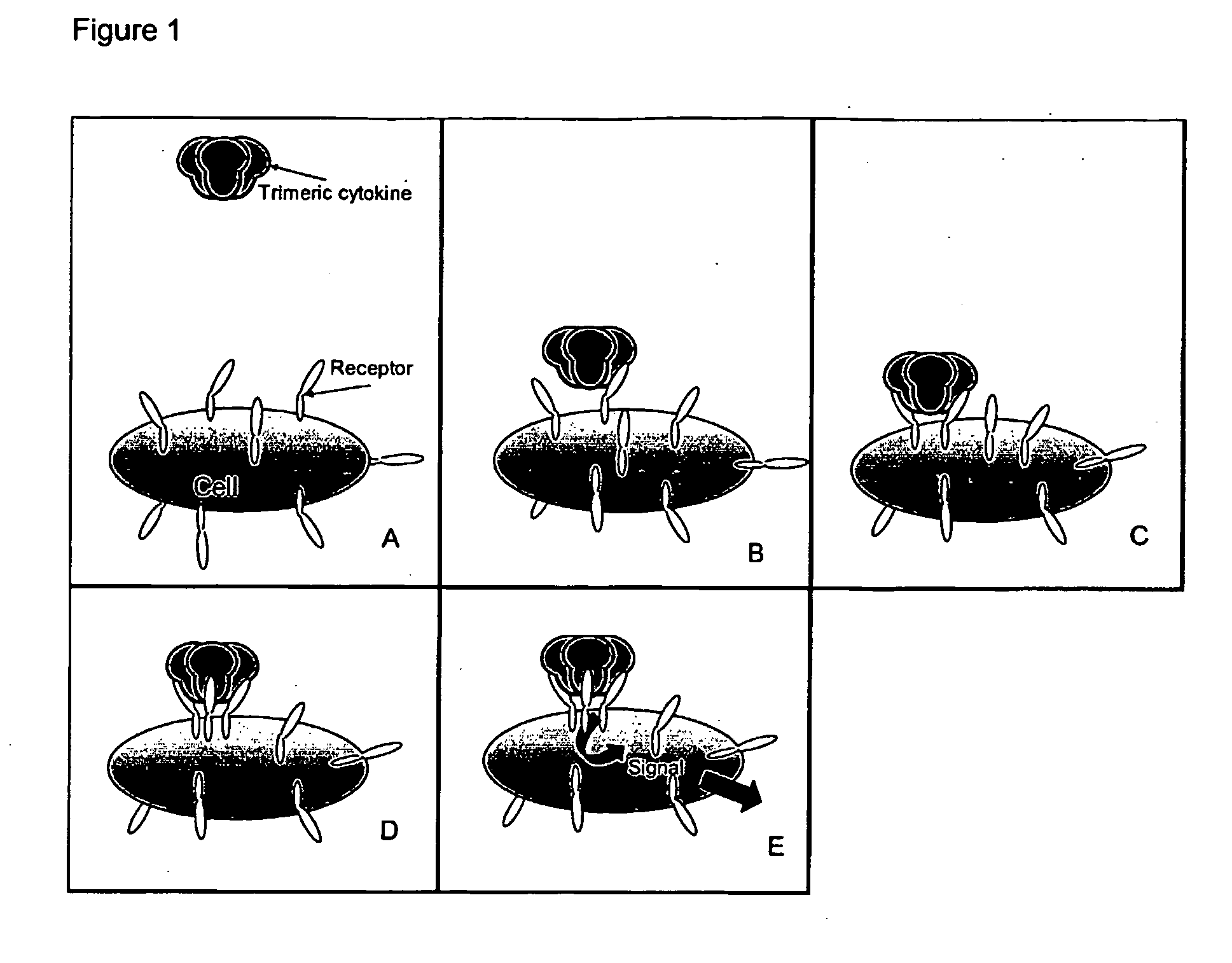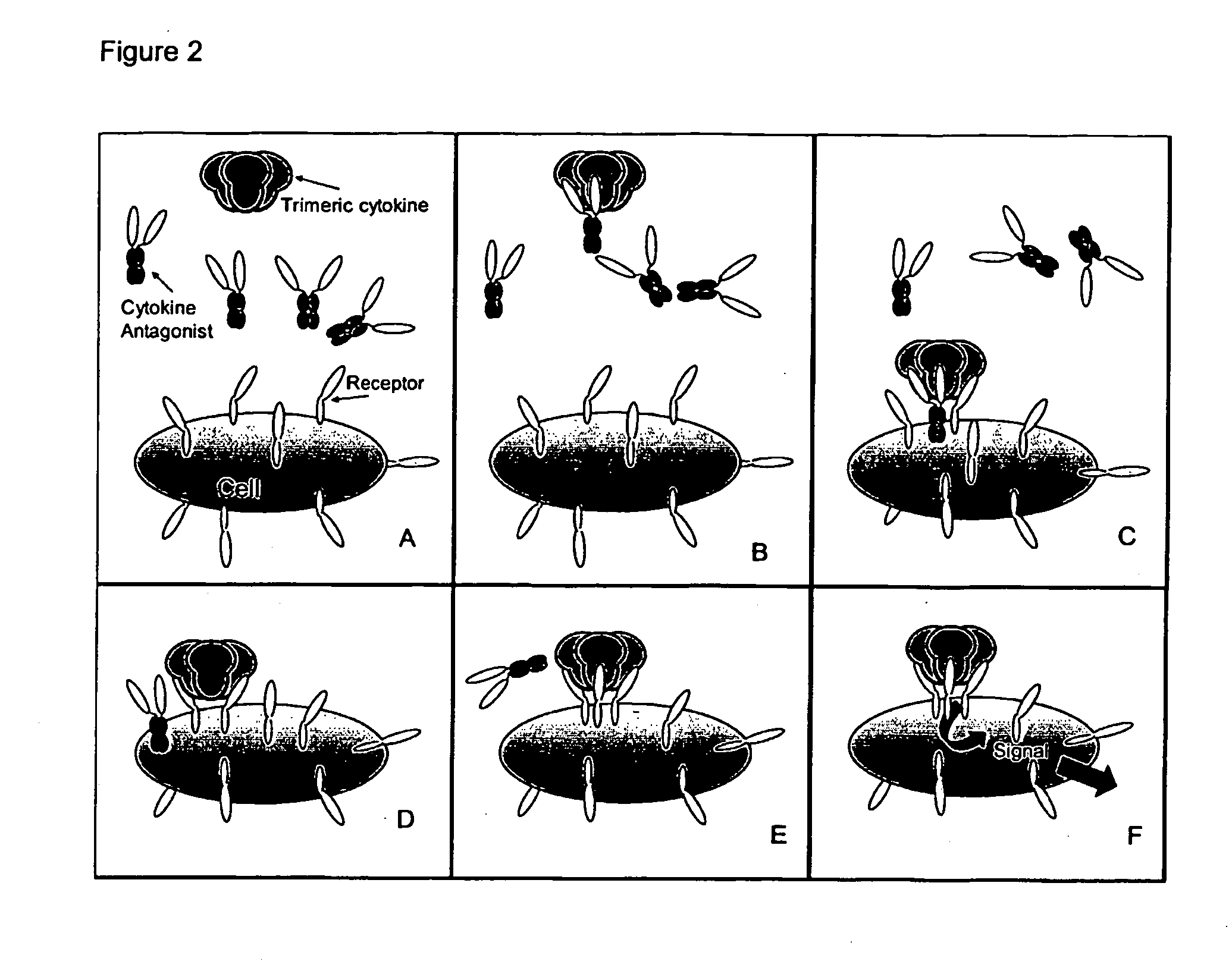Trimeric binding proteins for trimeric cytokines
a trimeric cytokine and binding protein technology, applied in the field of trimeric binding proteins, can solve the problem that not all three receptor binding sites of trimeric cytokine are effectively blocked
- Summary
- Abstract
- Description
- Claims
- Application Information
AI Technical Summary
Benefits of technology
Problems solved by technology
Method used
Image
Examples
example 1
Design and Construction of Trip E. coli Expression Plasmids and Phagemids for the Production of Trimeric Cytokine Binders
Phagemids
[0057] The phagemid, psktripB, was constructed by ligation of the Sfi I and Not I restricted DNA fragment sktripB amplified from the expression plasmid pTtripb with the oligonucleotide primers C-sfikpn-TRI (SEQ ID NO:1) and N-sfikpn-TRI (SEQ ID NO:2) into a Sfi I and Not I precut vector, pCANTAB 5E supplied by Amersham Pharmacia Biotech (code no. 27-9401-01) using standard procedures. The nucleotide sequences of the sktripB inserts is given as SEQ ID NO:3.
[0058] The phagemid, pskI10tripB, was constructed by ligation of the Sfi I and Not I restricted DNA fragment skI10tripB amplified from the expression plasmid pTtripb with the oligonucleotide primers C-sfikpn-TRI (SEQ ID NO:1) and N-sfikpn-I10TRI (SEQ ID NO:4) into a Sfi I and Not I precut vector, pCANTAB 5E supplied by Amersham Pharmacia Biotech (code no. 27-9401-01) using standard procedures. The nu...
example 2
Design and Construction of a Trimeric TNF Binders Using TNFRII Fragments
[0061] Fragments and subunits of the TNF receptor TNFRSF1B (TNFRII) was used for the construction of trimeric TNF binders based on the trimerising domain TripB derived from tetranectin. The design and cloning is outlined in the following:
Cloning of TNFRSF1B Fragments into Phagemid Vectors
[0062] The Phagemid vector pD1D2tripB, is constructed by ligation of the Sfi I and Kpn I restricted DNA fragment D1D2 amplified from cDNA, isolated from a mixture of human bone marrow and human leukocyte (Clontech Laboratories, Inc cat # 7181-1 and 7182-1) (with the oligonucleotide primers D1-rev (SEQ ID NO: 11) and D2kpn-fo (SEQ ID NO: 12)) into a Sfi I and Kpn I cut vector, psktripB using standard procedures. Outlines of the resulting nucleotide sequence of D1D2, is given as SEQ ID NO:13.
[0063] The Phagemid vector pD1D2, 1 / 6tripB, is constructed by ligation of the Sfi I and Kpn I restricted DNA fragment D1D1 / 6 amplified f...
example 3
Production, Refolding and Purification of Trimerised TNFRII Fragment AD1D4-GSS-I10-TripB
[0118] Construction of the T7 RNA polymerase dependent expression plasmid pT7D1D4GSSI10 (expressing the TNFRII derivative AD1D4-GSS-i10-TripB) is described above in Example 2.
[0119] Trimerised human TNFRII fragment AD1D4-GSS-I10 (SEQ ID NO:109) was produced by growing and expressing the plasmid pT7AD1D4-GSS-I10 in E. coli BL21 cells in a medium scale (6×1 litre) as described by Studier and Moffat, J. Mol. Biol., 189: 113-130, 1986. Briefly, exponentially growing cultures at 37° C. were at OD600 0.8 infected with bacteriophage λ-CE6 at a multiplicity of approximately 5. Cultures were grown at 37° C. for another three hours before cells were harvested by centrifugation. Cells were lysed by osmotic shock and sonification and total cellular protein extracted into phenol (adjusted to pH 8 with Trisma base). Protein was precipitated from the phenol phase by addition of 2.5 volumes of ethanol and cent...
PUM
| Property | Measurement | Unit |
|---|---|---|
| Fraction | aaaaa | aaaaa |
| Fraction | aaaaa | aaaaa |
| Molar density | aaaaa | aaaaa |
Abstract
Description
Claims
Application Information
 Login to View More
Login to View More - R&D
- Intellectual Property
- Life Sciences
- Materials
- Tech Scout
- Unparalleled Data Quality
- Higher Quality Content
- 60% Fewer Hallucinations
Browse by: Latest US Patents, China's latest patents, Technical Efficacy Thesaurus, Application Domain, Technology Topic, Popular Technical Reports.
© 2025 PatSnap. All rights reserved.Legal|Privacy policy|Modern Slavery Act Transparency Statement|Sitemap|About US| Contact US: help@patsnap.com



